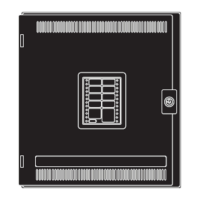1-12
Specifications, Continued
Major Panel
Components
Table 1-3. Major Panel Components (continued)
Component Description
Manual Release / Abort
Circuit (SPM1, SPM2)
Agent release systems use the Special Purpose Monitor (SPM1 and SPM2) circuits to
connect manual release switches and abort switches. Applications 10 and 11 (agent release
and Preaction/Deluge) use SPM1 for Abort/Manual and SPM2 for a pressure switch. Neither
SPM circuit supports the connection of smoke detectors. Switches must be normally open.
An activated release switch overrides the abort switch. The system tracks the abort switch
status to detect the release of the switch.
Pressure Switch
In a single hazard agent release system, IDC3 is reserved for use as a pressure switch
monitor. In applications 10 and 11 (Agent Release and Preaction/Deluge) SPM2 is reserved
for use as a pressure switch monitor. When used as a pressure switch monitor, a current-
limited or short circuit (non Style C) is interpreted as pressure switch activated, which then
causes notification appliances to sound. The circuit is supervised for open circuits, and the
panel generates a trouble if one occurs. No releasing circuits are activated when the
pressure switch activates.
Tamper Switch
In a single hazard, agent release system, IDC4 is reserved for use as a tamper switch
monitor. This includes applications 10 and 11 (Agent Release and Preaction/Deluge). When
used as a tamper switch monitor, a current-limited or short circuit (non Style C) is interpreted
as tamper switch activated, which causes a supervisory condition to be generated. The
system can be programmed to activate a NAC or relay in response to tamper switch
activation.
Notification Appliance
Circuits (NACs)
Two power-limited notification appliance circuits, each rated at 2A. NACs can play either
steady or pulsing tones, allowing the AutoPulse Z-10 to generate distinct pre-discharge
signals for agent release systems. Both circuits are power limited.
Releasing Appliance Circuits
(RAC)
Two circuits each rated at 2A. Releasing circuits operate simultaneously for single hazard
systems and independently for dual hazard systems. In applications 10 and 11 RAC2 is a
preaction RAC and will turn on before RAC1 unless the timer is set to 0. Both circuits are
power-limited.
Relays
Three on-board relays, each of which is selectable for either Normally Open or Normally
Closed operation. Each relay is rated for 2A, 30 VDC, 0.35 power factor (inductive).
Common trouble relay is normally energized. Off if a trouble occurs.
For Single Hazard operation, Relay 2 is the common alarm relay and Relay 3 is
programmable as common “Time Delay Started” or common “Supervisory”.
For Dual Hazard operation, Relay 2 is for Hazard Area 1 common alarm and Relay 3
is common for Hazard Area 2 alarm.
Auxiliary Power
Three terminals: + terminal is 24 V, - terminal is 0V Steady, and R terminal (reset) is 0V
with pulse on reset for 4-wire smokes. Combined rating is 750 mA for any combination of
steady/pulsed.
User Interface
Red Alarm LEDs for each initiating device circuit and manual release circuit. Red LED
to indicate agent release.
Yellow Trouble LEDs for each initiating device circuit, notification appliance circuit,
releasing appliance circuit, and abort and manual release circuit.
Dedicated Alarm Silence, Supervisory, Abort Active, and Earth Fault Trouble LEDs.
Green AC Power ON LED.
Switches for Acknowledge, Silence, and Reset. Pressing all three simultaneously for
five seconds disables notification appliance, releasing appliance, and relay circuits and
causes a trouble to be displayed. All four notification appliance and releasing appliance
trouble LEDs flash.
Piezo. On trouble conditions, the piezo sounder is on steady to indicate that a trouble
has occurred. It turns off when the Acknowledge key is pressed. On alarm conditions,
the sounder pulses until the Acknowledge key is pressed.

